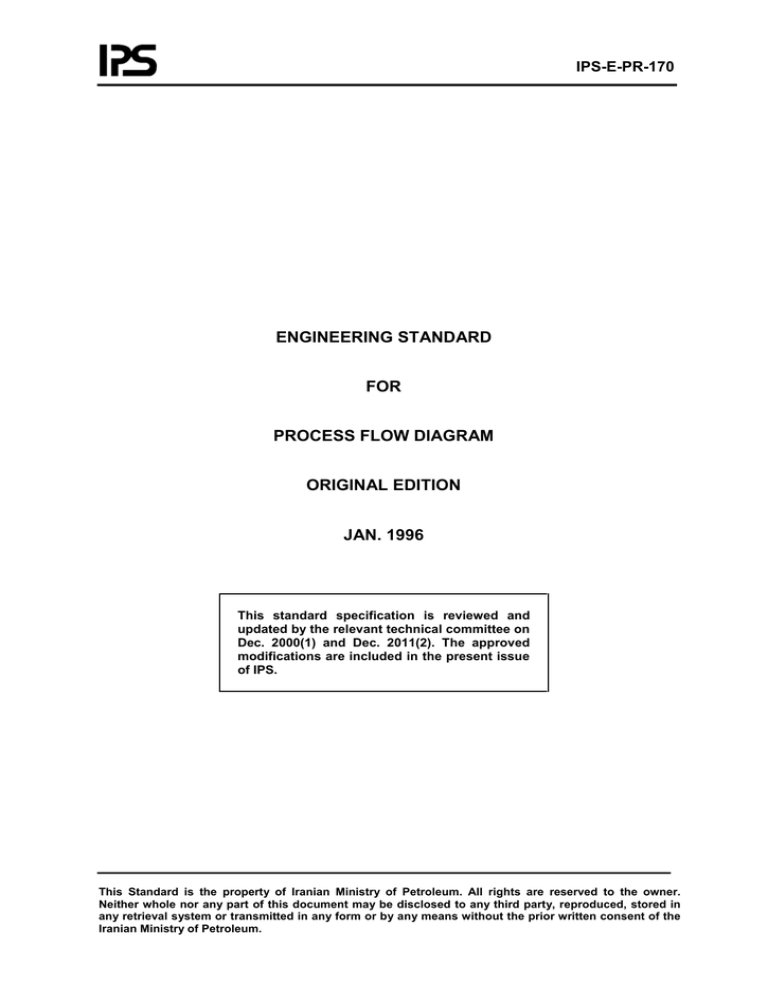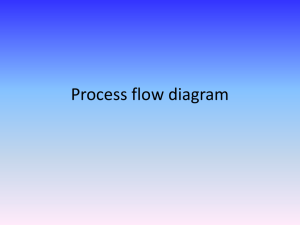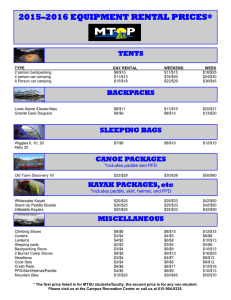
IPS-E-PR-170
ENGINEERING STANDARD
FOR
PROCESS FLOW DIAGRAM
ORIGINAL EDITION
JAN. 1996
This standard specification is reviewed and
updated by the relevant technical committee on
Dec. 2000(1) and Dec. 2011(2). The approved
modifications are included in the present issue
of IPS.
This Standard is the property of Iranian Ministry of Petroleum. All rights are reserved to the owner.
Neither whole nor any part of this document may be disclosed to any third party, reproduced, stored in
any retrieval system or transmitted in any form or by any means without the prior written consent of the
Iranian Ministry of Petroleum.
Jan. 1996
IPS-E-PR-170
FOREWORD
The Iranian Petroleum Standards (IPS) reflect the views of the Iranian Ministry of Petroleum and are
intended for use in the oil and gas production facilities, oil refineries, chemical and petrochemical
plants, gas handling and processing installations and other such facilities.
IPS are based on internationally acceptable standards and include selections from the items
stipulated in the referenced standards. They are also supplemented by additional requirements
and/or modifications based on the experience acquired by the Iranian Petroleum Industry and the
local market availability. The options which are not specified in the text of the standards are
itemized in data sheet/s, so that, the user can select his appropriate preferences therein.
The IPS standards are therefore expected to be sufficiently flexible so that the users can adapt
these standards to their requirements. However, they may not cover every requirement of each
project. For such cases, an addendum to IPS Standard shall be prepared by the user which
elaborates the particular requirements of the user. This addendum together with the relevant IPS
shall form the job specification for the specific project or work.
The IPS is reviewed and up-dated approximately every five years. Each standards are subject to
amendment or withdrawal, if required, thus the latest edition of IPS shall be applicable
The users of IPS are therefore requested to send their views and comments, including any
addendum prepared for particular cases to the following address. These comments and
recommendations will be reviewed by the relevant technical committee and in case of approval will
be incorporated in the next revision of the standard.
Standards and Research department
No.17, Street14, North kheradmand
Karimkhan Avenue, Tehran, Iran .
Postal Code- 1585886851
Tel: 88810459-60 & 66153055
Fax: 88810462
Email: Standards@ nioc.ir
1
Jan. 1996
IPS-E-PR-170
GENERAL DEFINITIONS
Throughout this Standard the following definitions shall apply.
COMPANY :
Refers to one of the related and/or affiliated companies of the Iranian Ministry of Petroleum such as
National Iranian Oil Company, National Iranian Gas Company, National Petrochemical Company
and National Iranian Oil Refinery And Distribution Company.
PURCHASER :
Means the “Company" where this standard is a part of direct purchaser order by the “Company”,
and the “Contractor” where this Standard is a part of contract document.
VENDOR AND SUPPLIER:
Refers to firm or person who will supply and/or fabricate the equipment or material.
CONTRACTOR:
Refers to the persons, firm or company whose tender has been accepted by the company.
EXECUTOR :
Executor is the party which carries out all or part of construction and/or commissioning for the
project.
INSPECTOR :
The Inspector referred to in this Standard is a person/persons or a body appointed in writing by the
company for the inspection of fabrication and installation work.
SHALL:
Is used where a provision is mandatory.
SHOULD:
Is used where a provision is advisory only.
WILL:
Is normally used in connection with the action by the “Company” rather than by a contractor,
supplier or vendor.
MAY:
Is used where a provision is completely discretionary.
2
Jan. 1996
CONTENTS :
IPS-E-PR-170
PAGE No.
1. SCOPE ............................................................................................................................................ 7
2. REFERENCES ................................................................................................................................ 7
3. DEFINITION OF PROCESS FLOW DIAGRAM (PFD) ................................................................... 7
4. PURPOSE OF PFD ......................................................................................................................... 8
5. CONTENTS OF PFD....................................................................................................................... 8
5.1 Inclusive ................................................................................................................................... 8
5.2 Exclusive .................................................................................................................................. 8
6. UNITS .............................................................................................................................................. 9
7. GENERAL DRAFTING INSTRUCTIONS ....................................................................................... 9
7.1 Scale ......................................................................................................................................... 9
7.2 Flow Direction ......................................................................................................................... 9
7.3 Process and Utility Lines in General..................................................................................... 9
7.4 Kind of Lines ......................................................................................................................... 10
7.5 Line Crossover ...................................................................................................................... 10
7.6 Denotation of Lines at Battery Limit Tie-In Points ............................................................ 11
7.7 Direction of Flow ................................................................................................................... 11
7.8 Division of PFD ...................................................................................................................... 11
7.9 Other Trains ........................................................................................................................... 12
7.10 Base Line ............................................................................................................................. 12
7.11 Title ....................................................................................................................................... 12
7.12 Legend ................................................................................................................................. 12
7.13 Size ....................................................................................................................................... 12
8. IDENTIFICATION AND NUMBERING OF EQUIPMENT ............................................................. 12
8.1 Process Equipment ............................................................................................................... 12
8.1.1 Letter of group ............................................................................................................... 12
8.1.2 Equipment number and name ...................................................................................... 12
8.1.3 Installed spare equipment ............................................................................................ 12
8.1.4 Equipment drivers ......................................................................................................... 12
8.1.5 Instrumentation .............................................................................................................. 13
9. DESCRIPTION OF EQUIPMENT ................................................................................................. 13
9.1 Symbols of Equipment and Operating Conditions ............................................................ 13
9.2 Minimum Information Requirements for Equipment/Streams.......................................... 13
9.2.1 Designated streams....................................................................................................... 13
9.2.2 Heat exchangers ............................................................................................................ 13
9.2.3 Furnaces ......................................................................................................................... 13
3
Jan. 1996
IPS-E-PR-170
9.2.4 Reactors.......................................................................................................................... 13
9.2.5 Columns.......................................................................................................................... 14
9.2.6 Drums.............................................................................................................................. 14
9.2.7 Pumps ............................................................................................................................. 14
9.2.8 Compressors and blowers............................................................................................ 14
9.2.9 Ejectors ........................................................................................................................... 14
9.2.10 Tanks............................................................................................................................. 14
9.2.11 Filters ............................................................................................................................ 14
a) Operating Temperature. ..................................................................................................... 14
1T
1T
b) Inlet and outlet operating pressure. ................................................................................. 14
1T
1T
10. DESCRIPTION OF INSTRUMENTATION .................................................................................. 14
1T
1T
10.1 Instruments .......................................................................................................................... 14
1T
1T
10.1.1 Symbols for instrument .............................................................................................. 14
1T
1T
10.1.2 Functional symbols for control .................................................................................. 15
1T
1T
10.1.3 Cascade control ........................................................................................................... 15
1T
1T
10.1.4 Compound control ....................................................................................................... 16
1T
1T
10.2 Measuring Devices.............................................................................................................. 16
1T
1T
10.2.1 Flow rate measuring .................................................................................................... 16
1T
1T
10.2.2 Level measuring .......................................................................................................... 16
1T
1T
10.2.3 Measurement of pressure, temperature, etc. ............................................................ 16
1T
1T
10.3 Control Valves ..................................................................................................................... 17
1T
1T
10.3.1 Actuator ........................................................................................................................ 17
1T
1T
10.3.2 Control valves .............................................................................................................. 17
1T
1T
11. MATERIAL BALANCE TABLE .................................................................................................. 17
1T
1T
11.1 Contents of Material Balance Table .................................................................................. 17
1T
1T
11.1.1 Stream information ...................................................................................................... 17
1T
1T
11.1.2 Operating conditions................................................................................................... 17
1T
1T
11.1.3 Basic physical properties ........................................................................................... 17
1T
1T
11.1.4 Data concerning hydraulic calculation ...................................................................... 17
1T
1T
11.2 Denotation of Material Balance Table ............................................................................... 17
1T
1T
11.2.1 Position of denotation ................................................................................................. 17
1T
1T
11.2.2 Number of digits of numerals and denotation of small quantities ......................... 18
1T
1T
11.3 Examples ............................................................................................................................. 18
1T
1T
12. HEAT AND MATERIAL BALANCE SHEETS ............................................................................ 18
1T
1T
13. PIPING AND EQUIPMENT SYMBOLS (SEE APPENDIX B) .................................................... 18
1T
1T
14. SYMBOLS OF OPERATING CONDITIONS .............................................................................. 19
1T
1T
4
Jan. 1996
IPS-E-PR-170
APPENDICES:
APPENDIX A
A TYPICAL TITLE BLOCK..................................................................................... 20
APPENDIX B
SYMBOLS ............................................................................................................... 21
5
Jan. 1996
IPS-E-PR-170
0. INTRODUCTION
The Standard Practice Manual titled as "Fundamental Requirements for the Project Design and
Engineering" is intended for convenience of use and a pattern of follow-up and also a guidance.
These Standard Engineering Practice Manuals, also indicate the check points to be considered by
the process engineers for assurance of fulfilment of prerequisitions at any stage in the
implementation of process plant projects.
It should be noted that these Iranian Petroleum Standards (IPS), as a Practice Manual does not
profess to cover all stages involved in every process project, but it reflects the stages that exist in
general in process projects of oil, gas and petrochemical industries of Iran.
These preparation stages describes the following three main phases which can be distinguished in
every project & includes, but not limited to:
Phase I)
Phase II)
Phase III)
Basic
Design Stages (containing Seven standards).
Detailed Design, Engineering and Procurement Stages (containing two Standards).
Start-up Sequence and General Commissioning
Procedures (containing two
Standards).
The process engineering standards of this group includes the following 11 Standards:
STANDARD CODE
STANDARD TITLE
I) Manuals of Phase I (Numbers 1-7)
IPS-E-PR-150
"Basic Design Package"
IPS-E-PR-170
"Process Flow Diagram"
IPS-E-PR-190
"Layout and Spacing"
IPS-E-PR-200
"Basic Engineering Design Data"
IPS-E-PR-230
"Piping & Instrument Diagrams (P&IDs)"
IPS-E-PR-250
"Performance Guarantee"
IPS-E-PR-308
"Numbering System"
II) Manuals of Phase II (Numbers 8 & 9)
IPS-E-PR-260
"Detailed Design, Engineering and Procurement"
IPS-E-PR-300
"Plant Technical and Equipment Manuals (Engineering Dossiers)"
III) Manuals of Phase III (Numbers 10 & 11)
IPS-E-PR-280
"Start-up Sequence and General Commissioning Procedures"
IPS-E-PR-290
"Plant Operating Manuals"
This Engineering Standard Specification covers:
"PROCESS FLOW DIAGRAM"
6
Jan. 1996
IPS-E-PR-170
1. SCOPE
This standard manual specifies the minimum general and specific requirements for the contents of
process flow diagram (hereinafter called PFD) which shall be used throughout OGP project.
However , further requirements may be requested by the company to fulfill specific project
requirements.
Note 1:
This standard specification is reviewed and updated by the relevant technical committee on
Dec. 2000. The approved modifications by T.C. were sent to IPS users as amendment No. 1
by circular No. 130 on Dec. 2000. These modifications are included in the present issue of
IPS.
Note 2:
This standard specification is reviewed and updated by the relevant technical committee on
Dec. 2011. The approved modifications by T.C. were sent to IPS users as amendment No. 2
by circular No. 317 on Dec. 2011. These modifications are included in the present issue of
IPS.
2. REFERENCES
Throughout this Standard the following dated and undated standards/codes are referred to. These
referenced documents shall, to the extent specified herein, form a part of this standard. For dated
references, the edition cited applies. The applicability of changes in dated references that occur
after the cited date shall be mutually agreed upon by the Company and the Vendor. For undated
references, the latest edition of the referenced documents (including any supplements and
amendments) applies.
ISO
(INTERNATIONAL ORGANIZATION FOR STANDARDIZATION)
ISO 7000-1984 (E/F),
"Graphical Symbols for Use on Equipment-Index and Synopsis"
1st. Ed. 1984-03-15
IPS
(IRANIAN PETROLEUM STANDARDS)
IPS-E-GN-100
“Engineering Standard for Units”
IPS-E-PR-230
“Engineering Standard for Piping & Instrument Diagrams (P&IDs)"
IPS-E-PR-290
“Engineering Standard for Plant Operating Manuals"
IPS-E-PR-308
“Engineering Standard for Numbering System"
3. DEFINITION OF PROCESS FLOW DIAGRAM (PFD)
Process flow diagram mainly defines:
a) A schematic representation of the sequence of all relevant operations occurring during a
process and includes information considered desirable for analysis.
b) The process presenting events which occur to the material(s) to convert the feedstock(s) to
the specified products.
c) An operation occuring when an object (or material) is intentionally changed in any of its
physical or chemical characteristics, is assembled or disassembled from another object or is
arranged or prepared for another operation, transportation, inspection or storage.
7
Jan. 1996
IPS-E-PR-170
4. PURPOSE OF PFD
The purpose of PFD is generally as follows:
a) Plant design basis
PFD shows the plant design basis indicating feedstock, product and main streams flow rates and
operating conditions.
b) Scope of process
PFD serves to identify the scope of the process.
c) Equipment configuration
PFD shows graphically the arrangement of major equipment, process lines and main control
loops.
d) Required utilities
PFD shows utilities which are used continuously in the process.
5. CONTENTS OF PFD
5.1 Inclusive
PFD shall comprise but not limited to the following items:
1) All process lines, utilities and operating conditions essential for material balance and heat and
material balance.
2) Utility flow lines and their types which are used continuously within the battery limits.
3) Equipment diagrams to be arranged according to process flow, designation, and equipment
number.
4) Simplified control instrumentation pertaining to control valves and the likes to be involved in
process flows.
5) Major process analyzers.
6) Operating conditions around major equipment.
7) Heat duty for all heat transfer equipment.
8) Changing process conditions along individual process flow lines, such as flow rates, operating
pressure & temperature, etc.
9) All alternate process and utility lines operating conditions.
10) Material balance table for essential streams.
5.2 Exclusive
The following items are generally not be shown on PFD, except in special cases:
1) Minor process lines which are not usually used in normal operation and minor equipment,
such as block valves, safety/relief valves, etc. unless otherwise specified.
2) Elevation of equipment.
8
Jan. 1996
IPS-E-PR-170
3) All spare equipment.
4) Heat transfer equipment, pumps, compressor, etc., to be operated in parallel or in series shall
be shown as one unit.
5) Piping information such as size, orifice plates, strainers, and classification into hot or cold
insulated of jacket piping.
6) Instrumentation not related to automatic control.
7) Instrumentation of trip system.
8) Drivers of rotating machinery except where they are important for control line of the process
conditions.
9) Any dimensional information on equipment, such as internal diameter, height, length, and
volume. Internals of equipment shall be shown only if required for a clear understanding of the
working of the equipment.
6. UNITS
This Standard is based on International System of Units (SI), as per IPS-E-GN-100 except where
otherwise specified.
7. GENERAL DRAFTING INSTRUCTIONS
7.1 Scale
PFDs should not be drafted to scale. However, their size should be compatible with that of
equipment drawings.
7.2 Flow Direction
As a rule, PFDs should be drawn from the left to the right in accordance with process flows.
7.3 Process and Utility Lines in General
The main process flow shall be accentuated by heavy lines.
Process utility lines shall be shown only where they enter or leave the main equipment unless
otherwise specified.
Pipe lines shall not be identified by numbers.
Valves, vents, drains, by-passes, sample connections, automatic or manual control systems,
instrumentation, electrical systems, etc. shall be omitted from the schemes.
The direction of the flow shall be indicated for each line.
9
Jan. 1996
IPS-E-PR-170
7.4 Kind of Lines
As a rule, Process lines, utility lines, and loop lines for instrument should be drawn according to
IPS-E-PR-230 as follows:
a) Main process lines
Thickness = 0.8 mm
b) Secondary process lines and utility line
Thickness = 0.5 mm
c) All electrical, computerand instrument
signals
Thickness = 0.3 mm
7.5 Line Crossover
Where two lines cross each other, the horizontal line should be drawn as a continuous line in all
cases. This shall not apply to loop lines for instruments.
a) Where two main process lines cross
b) Where one main line crosses one secondary
process and utility lines
c) Where one main line crosses one loop line for
an instrument
10
Jan. 1996
IPS-E-PR-170
7.6 Denotation of Lines at Battery Limit Tie-In Points
a) Process lines
From Item No. and/
To Item No. and/
or Dwg. No.
or Dwg. No.
Where a PFD consists of two or more divided sheets, drawing numbers should be indicated.
b) Utility lines
COOLING WATER
Names of fluids should be given in parentheses above the utility lines.
Names of these fluids should be as abbreviations defined according to IPS-E-PR-308.
7.7 Direction of Flow
The direction of flow should be indicated by arrows. In principle all flow lines should be denoted by
arrows located at the inlet of equipment, at merging points, and at the corners of the lines. Where a
process line is long, however, the process flow may be denoted by arrows located at intermediate
points.
The number of arrows used to denote one process flow line is not restricted. However, care should
be taken not to clutter the drawing with excessive arrows.
Arrows at corners may be suitably omitted.
7.8 Division of PFD
Where a PFD must be divided into two or more sheets, it should be divided at portions where
division is easiest from the process standpoint and each divided section should be drawn on a
separate sheet.
11
Jan. 1996
IPS-E-PR-170
7.9 Other Trains
Where there are two or more identical trains of process flows, one representative train may be given
in the PFD and the others omitted. However, notations pointing out such omissions must be clearly
indicated in the titles of all relevant PFDs to avoid confusion.
7.10 Base Line
As a rule, base lines should not be drawn. Similar items of equipment, however, should be aligned
at the same level as far as possible.
7.11 Title
The title should be given in the title block at the lower right-hand corner of the PFD. A typical title
block is shown in Appendix A.
7.12 Legend
The legend may be given in separate schematic drawing to which reference shall be made if
necessary.
7.13 Size
The size of PFD should normally be A1 (594 mm × 841 mm). The reduced size to A3 shall be
legible.
8. IDENTIFICATION AND NUMBERING OF EQUIPMENT
8.1 Process Equipment
8.1.1 Letter of group
Each item of equipment shall be identified by an identifying or a tag number composed of letter as
given in IPS-E-PR- 308.
8.1.2 Equipment number and name
The equipment number and name should be given in the PFD, as a rule, at the upper or the lower
part of the sheet, preferably in a space close to the center line of the equipment which is to be
denoted.
8.1.3 Installed spare equipment
Installed spare equipment, such as pumps, shall be indicated by a suffix letter like "A" or "B".
8.1.4 Equipment drivers
Equipment drivers shall carry the same designation as the driven equipment.
12
Jan. 1996
IPS-E-PR-170
8.1.5 Instrumentation
It is not necessary to assign an identifying number in the PFD.
9. DESCRIPTION OF EQUIPMENT
9.1 Symbols of Equipment and Operating Conditions
a) As a rule, piping and equipment symbols which are common to individual processes should
be unified. These are mentioned in Figs. 1.1-1.18.
Symbols to denote other equipment not specified in this standard manual shall be decided
during project execution upon the company’s approval.
b) Decimal numbers should be used inside the symbols mentioned in Fig. 2 to denote operating
conditions.
c) The position of the operating condition denotation should be as close as possible to the point
requiring indication. Where it is difficult to find space for such denotation, however, an auxiliary
line should be used to indicate it.
9.2 Minimum Information Requirements for Equipment/Streams
9.2.1 Designated streams
a) Stream numbers should be serially denoted by Decimal numbers.
b) Fluid name.
c) Total flow rate.
d) Density and/or molecular mass (weight) if required.
e) Operating pressure and temperature if required.
9.2.2 Heat exchangers
a) Identification number and service name.
b) Operating heat duty.
c) Inlet and outlet temperatures on both shell and tube sides.
9.2.3 Furnaces
a) Identification number and service name.
b) Operating absorbed heat duty.
c) Inlet and outlet operating temperatures on tube side.
9.2.4 Reactors
a) Identification number and service name.
b) Inlet and outlet operation temperature.
c) Inlet and/or outlet pressure.
13
Jan. 1996
IPS-E-PR-170
9.2.5 Columns
a) Identification number and service name.
b) Tray numbers, operating temperature and pressure for top and bottom trays and also for
special trays such as feed and draw-off, etc.
c) Trays shall be numbered from bottom to top.
9.2.6 Drums
a) Identification number and service name.
b) Operating temperature.
c) Operating pressure.
9.2.7 Pumps
a) Identification number and service name.
b) Normal operating capacity and differential pressure.
9.2.8 Compressors and blowers
a) Identification number and service name.
b) Normal operating capacity and differential pressure.
9.2.9 Ejectors
a) Identification number and service name.
b) Inlet and outlet operating pressure for ejector system.
9.2.10 Tanks
a) Identification number and service name.
b) Operating temperature.
c) Operating pressure.
d) Tank capacity.
9.2.11 Filters
a) Operating Temperature.
b) Inlet and outlet operating pressure.
10. DESCRIPTION OF INSTRUMENTATION
Instrumentation to be denoted are instruments, measuring devices and control valves.
10.1 Instruments
10.1.1 Symbols for instrument
a) The symbol for an instrument is a circle which shall be connected to the line which is nearest
14
Jan. 1996
IPS-E-PR-170
the point of measurement.
b) Where the instrument is a controller, a dotted line representing the control impulse shall
connect the instrument circle to the controller valve.
c) The denotation of such functional symbols as "R" for recorder, "I" for indicator, and "A" for
alarm, etc. should be omitted except for the functional symbol "C" for control.
- There should be no distinction as to whether instruments should be locally installed or
mounted on the main instrument panel.
10.1.2 Functional symbols for control
The following symbols are shown inside the circle representing the instrument. For further details
refer to IPS-E-PR- 308.
Flow Controlling
FC
Flow Ratio Controlling
FRC
Level Controlling
LC
Pressure Controlling
PC
Pressure Differential Controlling
PDC
Temperature Controlling
TC
Temperature Differential Controlling
TDC
Speed Controlling
SC
Mass (Weight) Controlling
MC
10.1.3 Cascade control
Where one controller alters the desired value of one or more other controllers, the instruments
circles shall be connected by a dotted line.
15
Jan. 1996
IPS-E-PR-170
10.1.4 Compound control
Where the control actions of two or more controllers combine to operate one or more control valves,
the instrument circles representing the controllers shall be joined by dotted lines to the instrument
circle representing the combining device.
10.2 Measuring Devices
The connecting line between the circle representing the instrument and the stream line represents
the measuring device such as for temperature measurement, pressure measurement, flow rate
measurement, etc.
10.2.1 Flow rate measuring
Regarding flow rate measurement, definitions of apparatus type such as rotameter, pitot tube,
turbine meter, Valves associated with the device need not be shown.
10.2.2 Level measuring
a) Definitions of apparatus type such as ball float, displacement, difference pressure, etc., need
not be shown.
b) A distinction should not be made as to whether the apparatus is an internal or external type.
c) Valves associated with the device need not be shown.
10.2.3 Measurement of pressure, temperature, etc.
a) No distinction should be made regarding measuring type.
b) Valves associated with measuring devices need not be shown.
16
Jan. 1996
IPS-E-PR-170
10.3 Control Valves
10.3.1 Actuator
a) The symbol for an actuator is a half circle which shall be connected with a dotted line
representing the control impulse.
b) There should be no distinction made as to whether the actuator is a diaphragm type, electric
motor type or oil cylinder type, etc.
10.3.2 Control valves
Control valves operated by instruments are shown as following:
11. MATERIAL BALANCE TABLE
11.1 Contents of Material Balance Table
A material balance table as typically shown in Table-1 shall consist of at least the following
information :
11.1.1 Stream information
Stream No., name of stream, flow rate, composition.
11.1.2 Operating conditions
Operating temperature and pressure.
11.1.3 Basic physical properties
Molecular mass (weight), API gravity, Relative Mass Density (Specific Gravity) or (Sp.Gr.), etc.
11.1.4 Data concerning hydraulic calculation
Density, viscosity, etc. if required.
11.2 Denotation of Material Balance Table
In preparation of material balance Table, care should be given to the following points:
11.2.1 Position of denotation
As a rule, the material balance table should be inserted at the lower part of the PFD.
17
Jan. 1996
IPS-E-PR-170
11.2.2 Number of digits of numerals and denotation of small quantities
As a rule, percentages should be expressed down to 0.01%. Where traces of components are
concerned, special units, such as ppm, should be used.
11.3 Examples
A typical material balance table is shown in Table 1.
TABLE 1 - TYPICAL MATERIAL BALANCE TABLE
STREAM No.
Fluid name
Components
101
mol/h or mol%
or
mass/h or mass%
102
Spec.
and/or
and/or
MW
BP
MP
A
B
C
D
E
Total flow rate (mol/h)
Total flow rate (mass/h), in (kg/h)
Total flow rate (volume/h), in (m3/h)
For liquids at operating conditions, and in (Nm3/h) for gases
Operating pressure, in kPa (ga) or bar (ga)
Operating temperature, in (°C)
Molecular mass (weight), in (kg)
Relative mass density (specific gravity) at standard conditions, dimensionless
Mass density at operating conditions, in (kg/m3)
Others
Remarks
12. HEAT AND MATERIAL BALANCE SHEETS
When preparing the heat and material balance sheets in addition to material balance tables,
necessary reference should be made to PFD stream numbers.
The heat and material balance sheets should be prepared as typically shown in IPS-E-PR-290
13. PIPING AND EQUIPMENT SYMBOLS (SEE APPENDIX B)
18
Jan. 1996
14. SYMBOLS OF OPERATING CONDITIONS
SYMBOLS OF OPERATING CONDITIONS
Fig. 2
Note:
Decimal numbers should be inserted inside the symbols.
19
IPS-E-PR-170
Jan. 1996
APPENDICES
APPENDIX A
A TYPICAL TITLE BLOCK
20
IPS-E-PR-170
Jan. 1996
APPENDIX B
SYMBOLS
21
IPS-E-PR-170



